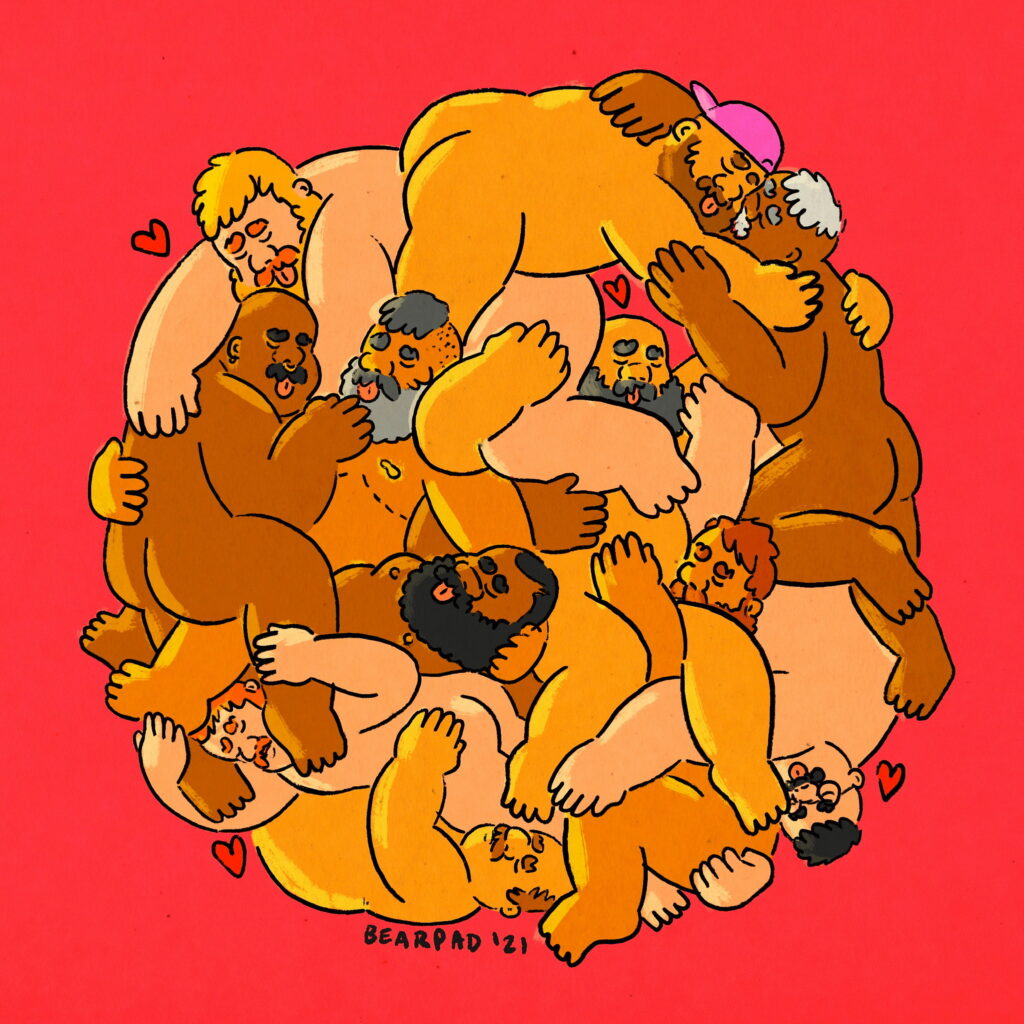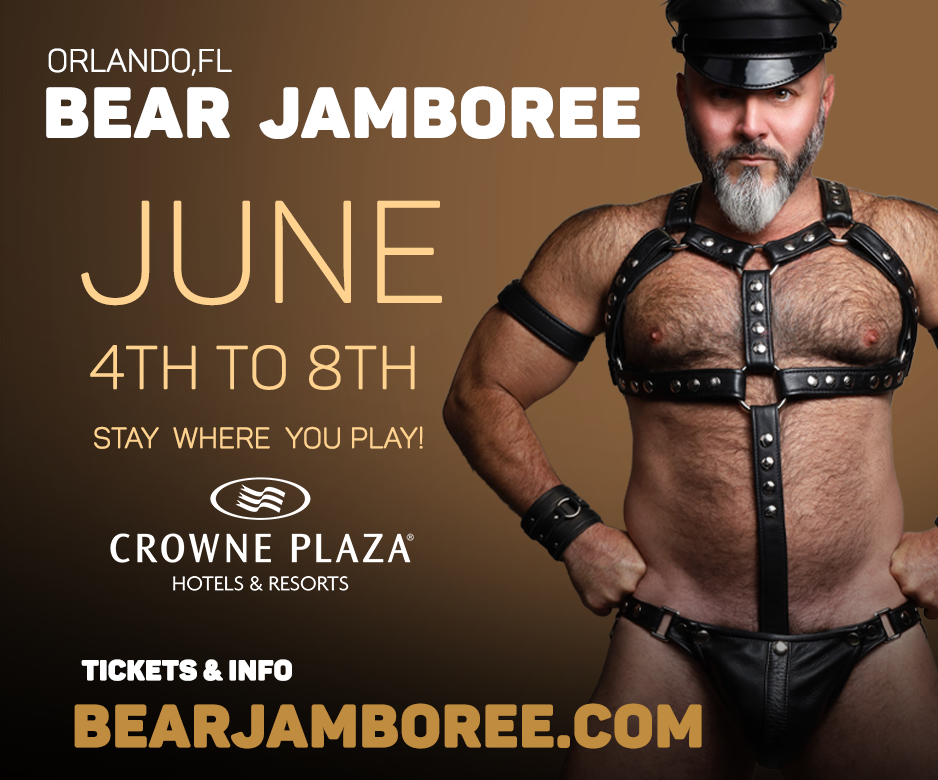
Bear Tracks: Bear Culture
In the broadest sense, culture encompasses social behavior, institutions, and cultural norms (what is considered acceptable behavior). Cultural universals are found in every culture and subculture—art, music, dance, literature, philosophy, mythology, political organization, technology (clothing, tool usage, cooking), rituals, and spiritual practices (“religion”). Anthropologists examine how human experiences are classified, encoded, and communicated symbolically. Sociologists examine the ways of thinking, ways of acting, and the material objects that define a culture. Contemporary cultural studies scholars examine the meaning and practices of everyday life. They consider traditional high culture, mass culture, and popular culture. They look at films, photographs, fashion, hairstyles, advertising, entertainment, audience reactions to and uses of mass culture (like manga or fandom). Culture psychologists explore the relationship between emotions and culture. For example, they have studied culture shock, including the wide-ranging responses of dominant cultures to LGBT culture.
Cultural change arises out of a tension between forces that encourage change and forces that resist change. Subcultures arise when the changes an emerging new group are making are rejected by the established culture. Cultural identity is especially important to emerging new groups. An individual’s cultural identity consists of three components—cultural knowledge (understanding their culture’s core characteristics), category label (indirect membership in that culture), and social connection (connections through social relationships). Dennis Altman documented how LGBT Americans conceptualized their identity following the model of ethnic minorities. The process of coming out into the LGBT community and (either simultaneously or subsequently) into the leather, bear or other subcommunity, is the first step toward creating a cultural identity for oneself and finding one’s place in that community and culture. Bears emerged in the earliest days of the internet, bear identity, community, and culture shaped by our globalized culture.

The internet has played an increasingly important role in shaping identity, (bears now often discover the bear community and come out online first). Social relations often begin in the virtual world, which is often the primary source of self-worth within the bear community. The saturation of young, handsome, gym-sculpted bodies, and huge (often photoshopped) cocks in the virtual world creates a fantasy world of “real” bears. The self-presentation (on Facebook) of bears sharing only the best aspects of their lives (happy circles of friends, beautiful homes, travel to fashionable places) create the fantasy of “perfect” lives, bears living the American Dream. This frequently results in low self-esteem, depression, and an acute sense of isolation—now at crisis level among American youth of every sex and gender.
Bears emerged in the middle of the AIDS epidemic. The epidemic wiped out most of a generation of gay men—this removed an entire generation of gay men who would have mentored the next generation. The earliest bears had no mentors; we loosely followed the leather community model. Individual bears are now mentoring the younger, third generation bears. This is needed as they have no knowledge of our history or foundational values. For too many, the long and short of bearness is “eating, drinking, and f*cking.”
As a subset of the larger LGBT culture, bear culture shares features distinct to the LGBT in general and gay men’s culture in particular. Bears quickly developed our own colloquial language (for example, “woof,” “huzbear,” “grrr,” “bear soup”). We now have our cultural icons (models and porn stars, like Jack Radcliffe and Hunter Harden; early shapers of culture, like Richard Bulger, Lurch, and John Burrows); and bear pop stars, like Benjamin Koll). With our roots in the Stonewall-era gay liberation, one hallmark of our liberation was expressed through our sexual exuberance. (“Promiscuity” is a harshly judgmental, stigmatizing word choice.)
As we have become mainstreamed and, especially following the legalization of same-sex marriage, there has been a shift toward more and more gay men promoting and practicing monogamy. An undercurrent of this shift away from gay men who are not interested in recreational sex has been a gradual imposition of mainstream heterosexual values, stigmatizing gay men who fail to conform to the new puritanism. Bears, in particular, have been the target of this.

One example of this is found in a 2015 review of health risks in the bear community, which found that “bears [are] more likely than other gay men to engage in condomless anal sex with casual partners, which is concerning due to anal sex being the act with the highest rate of sexually transmitted infections.” Married to David Burtka, with whom he has two children, out gay actor and philanthropist Neil Patrick Harris said in 2008, “I’m a big proponent of monogamous relationship regardless of sexuality, and I’m proud of how the nation is steering toward that.”
The plethora of LGBTQIA identities, including bears, were caused by stigmatizing and socially rejecting us because of our sexual practices and romantic attachments. Hence, the resultant communities and cultures can never be completely separated from their roots in sexuality. Like all LGBTQ subcultures, the newly emerging bear subculture expresses our individual and collective sensibilities through the prism of our sex (and gender) differences, which permeate and define us.
In 1956 Erich Fromm published his book The Art of Love. In it he asserted the then revolutionary idea that love is not a passive emotion but rather an active practice that requires discipline, maturity, and understanding. According to Fromm, love is not something that just happens but is an art that requires knowledge and effort. This understanding permeated 1960s counterculture and was celebrated in music, in “love-ins,” in embracing free love. It reached its apotheosis in the music and art lovefest known as Woodstock. Despite the unanticipatedly massive turnout—which turned Max Yasgur’s farm into an uncomfortable mud bath and resulted in food and bathroom shortages—the crowd “kept up kindness and good cheer among themselves. As the half-million people in the audience became aware of this, a warm feeling of friendship spread to everyone.”

Bears have developed a subculture of our own, with cultural institutions, such as bear bars (social and sexual meeting grounds), bear sex venues (personal ads, the internet, play parties, semiotic coding in attire), organized social events (bear runs and bear weekends), bear clubs (formal and informal), bear contests, and a bear press. As bear community has grown–as bear identity has evolved, as a desire to recognize our distinguishing values, rituals, and social bonds–we now codify and celebrate through popular and high culture. Our founding values of acceptance, relative nonjudgmentalness, the practice of bear hugs, and the camaraderie of warmth and nurturing fellow feeling are expressions of Fromm’s idea of love that “permeates all aspects of life, including our interactions with strangers, friends, and society at large.”
Bear culture has emerged and coalesced as a celebration of our tribal values. It is notable that the culture makers in the bear community place commitment to the bear community rather than remunerative commercial success. Our culture makers’ attitude and orientation of character echoes Fromm’s vision of love that nurtures the growth and well-being of our community and the members of our tribe.
Here is a partial list of past and present bear culture makers:
- actors (Guillermo Diaz, Joshua Pangborn),
- artists (J. S. Adams, Charlie Hunter, Tim Goecke, BEARPAD, Don Chooi, Kenney Mencher, Ian Fernandez, Herzfarbenrauch, David Addison Small, Marco Veloso, Fran Frisch),
- authors (Raymond Luczak, Glenn Quigley, Zachary Zane, Daryl McCullough, Jason B. Crawford, Jeff Mann, Wayne Hoffman, Dylan Drake)
- comedians (Joseph Schless, Marquis The Honey Bear).
- comics (Krit, Steve Maclsaac, Japanese bear manga artists [Jiraiya, Seizoh Ebisubashi, Kazuhide Ichikawa], Tim Barela),
- cultural historians (Les K. Wright, Ron Suresha, Peter Hennen, Rainer Hörmann,Nick McGlynn, Jason Whitesel, and Ray Kampf),
- drag bears (Meatball, Nina West, BlackBerri, Lucy Stool, Grace Towers, Temple Grande, Harriet Tugsman),
- films (Where the Bears Are [Joe Dietl], Cachorro [Miguel Albaladejo], Big Boys [Corey Sherman], Campfire [Austin Bunn]), Bear City [Douglas Langway ], A Bear’s Story [Kyle Krieger], Asking to See the Soul [Barth Cox], Bear Nation [Malcolm Ingram], and Bear Run: Celebrating the Bear Community [Dan Hunt],
- go-go bears (J-Mo Bear, Hunter Harden, Beltrán),
- music (Bearapalooza, Freddy Freeman, Reverend Yolanda, Martin Swinger, Tom Goss, Nakia, Benjamin Koll),
- photographers (Chris Komater, Chris Nelson, Mack Sturgis, Joshi, Josh Williams, Jack Fritscher, Rich Stadtmiller, Lynn Ludwig),
- porn stars/models (Jack Radcliffe, JD Dress, Drake Jensen, Santana XXL, Satori Agape),
- rappers (Roulette Delgado, Big Dipper, Dan Midas, Chris Conde),



Bear culture is vibrant, growing, and inflected by the unique LGBT culture in different societies across the world—all a testament to our viability as a maturing community. I continue to expand my knowledge and understanding of bear communities and aim to present as comprehensive an overview of bear culture in Bear Book III.
My thanks to John Hernandez for sharing his knowledge of the current entertainment culture in the bear community.
Help Les K Wright in his quest to document bear history by joining the Bear History Project International where you and a group of like-minded individuals can exchange ideas and help to preserve bear history and culture.









